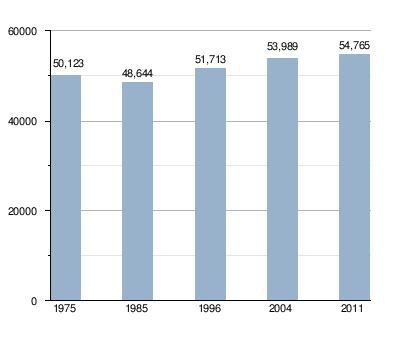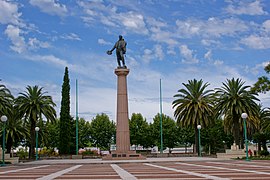Río Negro Department
Río Negro | |
|---|---|
 San Javier, Plaza de la Libertad - Homage to Russians inmigrants. | |
 Location of Río Negro, in red, in Uruguay | |
| Coordinates: 33°7′29″S 58°18′1″W / 33.12472°S 58.30028°W | |
| Country | |
| Creation | 20 March 1880 |
| Capital | Fray Bentos |
| Government | |
| • Intendant | Oscar Terzaghi [1] |
| Area | |
| • Total | 9,282 km2 (3,584 sq mi) |
| Population (2011)[2] | |
| • Total | 54,765 |
| • Density | 5.9/km2 (15/sq mi) |
| Time zone | UTC-03 (UYT) |
| ISO 3166 code | UY-RN |
| Website | Official website |
The Río Negro department (Spanish: Departamento de Río Negro) is a department of Uruguay. The capital is the city of Fray Bentos.
Its ISO 3166-2 code is UY-RN.
History
[change | change source]The Río Negro department was created on 20 March 1880. Before that time, its territory was part of the Paysandú department.
Geography
[change | change source]
The Río Negro department is in the western part of Uruguay, along the Uruguay river. It has an area of 9,282 km2 (3,584 sq mi). The population is 54,765 inhabitants (2011 census), one of the departments with fewest inhabitants, for a population density of 5.9 inhabitants/km2.
There are two chains of low hills in the department. These chains of low and rounded hills are named cuchillas in the country. The two cuchillas in the department are cuchilla de Navarro to the south and forming the border with the Durazno department, and cuchilla de Haedo that goes from the northeast to the southwest.
There are two protected areas in the department: National Park Esteros de Farrapos e islas del río Uruguay (Spanish: Parque Nacional Esteros de Farrapos e islas del río Uruguay) and the Esteros y algarrobales del río Uruguay.
Limits
[change | change source]- To the north: Paysandú department.
- To the east: Tacuarembó department.
- To the southeast: Durazno department, separated by the Río Negro river.
- To the south: Soriano department, separated by the Río Negro river.
- To the west: Argentina, separated by the Uruguay river.
Rivers
[change | change source]The main rivers in the department are:
- Uruguay, to the west and that forms the border with Argentina; and
- Río Negro that flows along the southern border of the department, forming the natural border with the departments of Durazno to the southeast and Soriano to the south.
Demographics
[change | change source]The inhabitants of the Río Negro department (and of the city of Paysandú) are known, in Spanish, as Rionegrenses.
Evolution of the population in Río Negro[3]

- Rural population
According to the 2011 census, the Río Negro department has a rural population of 5,212, that represents 9.5% of the total population of the department.[2]
- Main towns
| City / Town | Population[2] (2011) |
|---|---|
| Fray Bentos | 24,406 |
| Young | 16,756 |
| Nuevo Berlín | 2,450 |
| San Javier | 1,781 |
Gallery
[change | change source]-
Church of Fray Bentos.
-
Artigas square, Fray Bentos.
-
Memorial with stone from the Berlin Wall, Nuevo Berlín
-
Esteros de Farrapos.
Related pages
[change | change source]References
[change | change source]- ↑ "Intendente" (in Spanish). Intendencia de Río Negro. Retrieved 6 August 2017.
- ↑ 2.0 2.1 2.2 "Censos 2011 - Departamento Río Negro". Instituto Nacional de Estadística. 10 August 2012. Archived from the original on 13 November 2017. Retrieved 6 August 2017.
- ↑ "Departments of Uruguay". Statoids. Retrieved 6 August 2017.
Other websites
[change | change source]- Intendencia de Río Negro website (in Spanish)
- Statoids - Departments of Uruguay
- Enciclopedia Geográfica del Uruguay: Río Negro (in Spanish)





